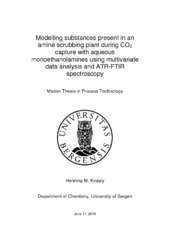Modelling substances present in an amine scrubbing plant during CO2 capture with aqueous monoethanolamines using multivariate data analysis and ATR-FTIR spectroscopy
Master thesis
Permanent lenke
https://hdl.handle.net/1956/18256Utgivelsesdato
2018-06-20Metadata
Vis full innførselSamlinger
Sammendrag
Since the 19th century, an increase in the earth’s temperature has been recorded. The rise in temperature is caused mainly by anthropogenic greenhouse gases, such as CO2. Industrial processes are the cause of 40% of the anthropogenic CO2 emissions. To lower the concentration of greenhouse gases several carbon capture and storage systems have been introduced to power plants. Post-combustion carbon capture systems using chemical absorption by amines are the most promising solution as they can be retrofitted to already existing power plants. This master’s thesis is written in collaboration with Technology Center at Mongstad and aim to provide an inline model to predict CO2 loading, monoethanolamine (MEA) concentration and the concentration of degradation products. Multivariate methods such as principal component analysis, partial least square and variable selection are applied to the data to build a model. A model for inline analysis could potentially improve efficiency and decrease cost, as well as provide continuous monitoring of the process. This would optimize component regulations involved in the process, such as amine loading, the temperature of the stripper and flow rate of CO2 into the system. Total inorganic carbon, total alkalinity, and density have been investigated for both CO2 - lean and CO2-rich solutions. All models obtained have yielded in low root mean square error predictions (RMSEP), compared to the value of the response. The RMSEP values as a percentage of the average response value resulted in a maximum of 2,3 % for the total inorganic carbon model in the lean samples and a minimum of 0,003 % for the density model built on the rich samples.
